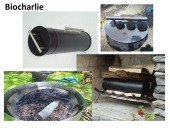posted 3 years ago
I really want to enable continuous or fed batch pyrolysis for smaller scale biochar production, and my feedstock of interest (shredded sweet sorghum bagasse) is better suited for retorts because of the small particles present. I'm thinking of trying out a design where the feedstock travels in a metal chute through a combustion chamber insulated with ceramic fiber board, and then the finished product can be collected in an airlock at the end (maybe even some quenching there too).
Heat could be provided either by a regular fire or maybe a small rocket stove. The chute would contain vents that allow the pyrolysis gases to escape into the combustion chamber so that they could be burned before going up the chimney, and a thermocouple inside the chute could be used to indicate when the feedstock train needs to advance (you could theoretically use this signal to automate the system).
Something that intrigues me is the suggestion to incorporate a catalytic combustor from a woodstove, to facilitate ignition of the pyrolysis gases. I hate seeing all the energy lost in afterburners. But I also don't know how best to place 1) the combustor, 2) the vents on the chute, or 3) the secondary air supply.
I put the chute on a slight decline so that gravity helps move the material along (maybe less pushing = less compaction?); and maybe also help move the pyrolysis gases away from the finished material, towards the starting material. (i.e., I would rather have the volatiles condense on the incoming material than on the finished product). But I don't know if any of that really makes a difference.
Anyway, this is very much in the brainstorming stage, and I'd appreciate hearing any suggestions you might have.
Retort_w_combustor.JPG
![Filename: Retort_w_combustor.JPG
Description: [Thumbnail for Retort_w_combustor.JPG]](/t/173097/a/165352/thumb-Retort_w_combustor.JPG)







